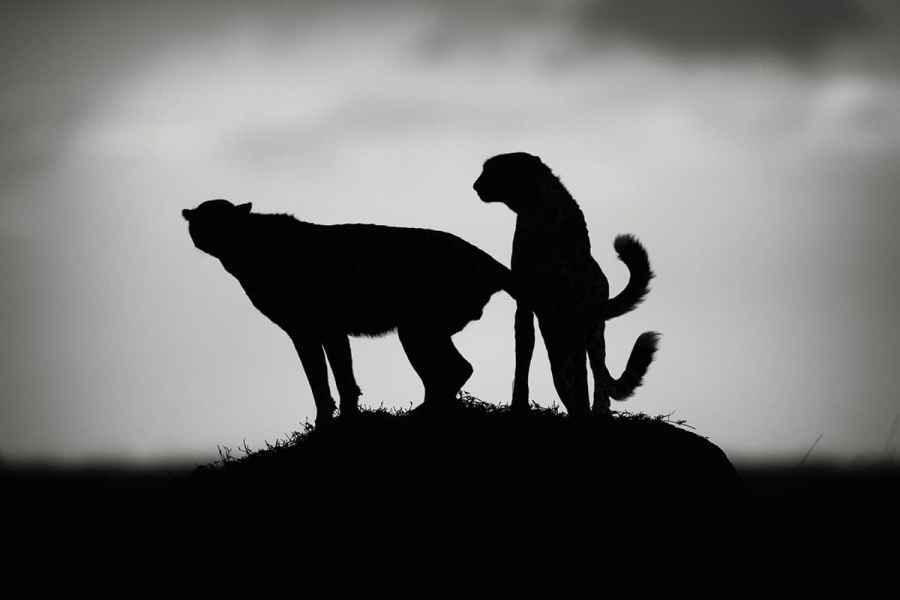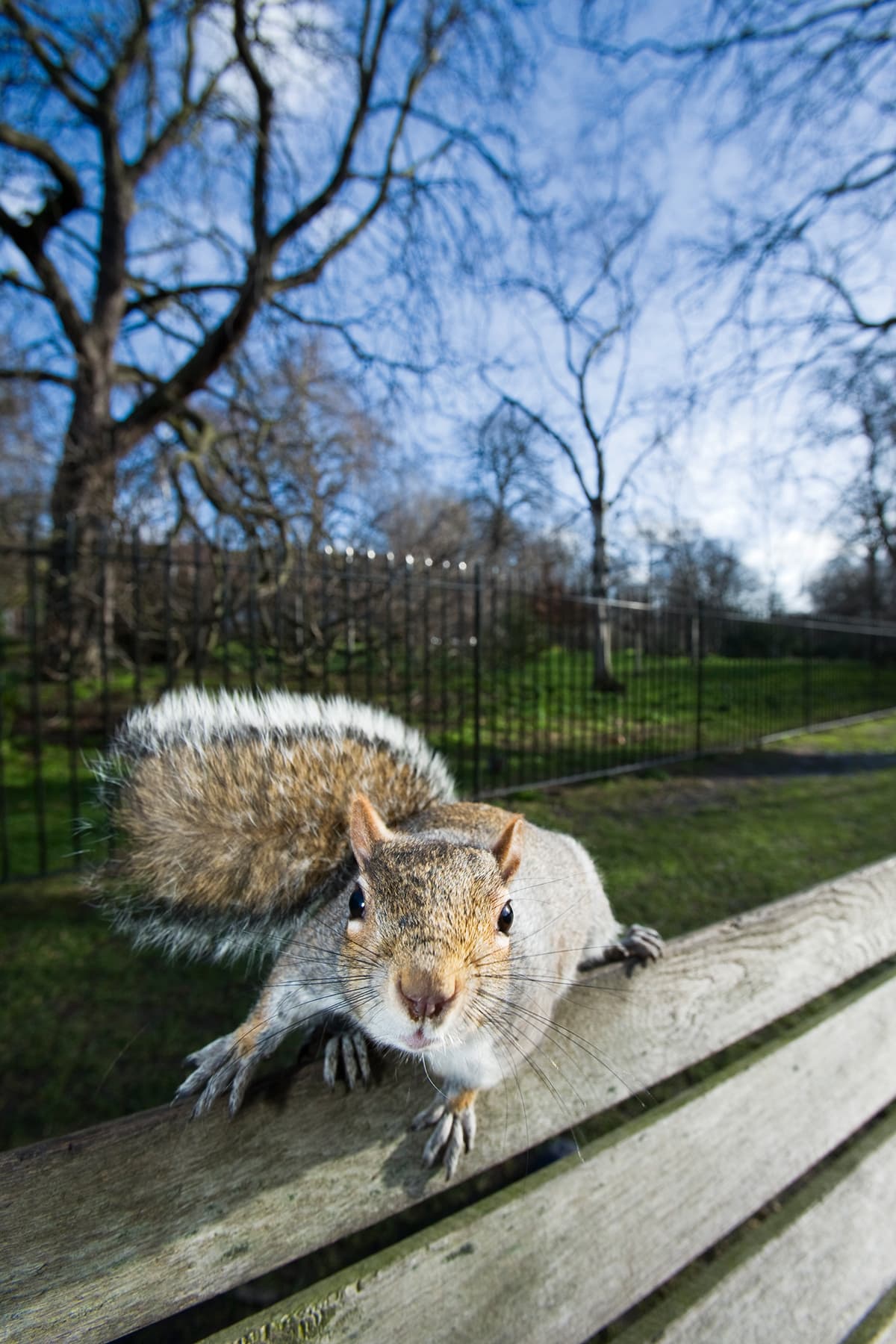If you’re looking into photographing wildlife, whether that’s wild animals or creatures closer to home, this guide from professional photographer Elliot Neep is for you.
From the vast open planes of the Mara Serengeti to the more humble fields on his south Oxfordshire doorstep, wherever the location, Elliott Neep manages to capture the true spirit and character of every animal he photographs. It’s a notoriously difficult feat, so how does he do it? Elliott’s skill lies in the fact that he is as much a naturalist as he is a photographer, using his knowledge of animal behaviour to get the shots that count.
What are the benefits of studying animal behaviour for wildlife photographers?
‘The more you can learn about your subject, the more you can anticipate and predict the animal’s behaviour,’ explains Elliott. ‘For me, photographing wildlife is all about capturing those special fleeting moments – whether it is a mother and cub coming into frame to nuzzle, or the moment a bird of prey takes flight. If you can recognise the signs and body language, you can shave valuable seconds off your reaction time and be ready for the moment.’

Photographing Wildlife – Mature lion (Panthera leo nubica). One of two brothers, yawning in dawn sunlight, Masai Mara National Reserve, Kenya
Photographing Wildlife – Practice makes perfect
It has taken Elliott many years to fine-tune his craft. He spent his formative years practising his camera techniques on local flora, fungi, bugs and pond wildfowl, getting to know his camera inside and out so as not to miss a moment by fiddling with settings and controls. This means he now instinctively knows how to seize the opportunities he is presented with, be it in a hide or a vehicle on safari. This, alongside his knowledge of animal behaviour, has been crucial in ensuring his photos manage to capture not just the animal’s profile, but its true character, too.
‘All the time, I am thinking about capturing and revealing the character of the animal – what is most representative and familiar to that species,’ reveals Elliott. ‘I want the animal to look relaxed and natural for portraits, so I’m looking for eye contact, a raised paw as the animal walks, ears alert and forward. If there is more than one animal, then I’m always looking for interaction, whether it is mutual grooming between siblings, parents and young, or an aggressive territorial dispute. Facial expressions and motion really bring the images to life.’
A waiting game
Elliott stresses that this style of photography takes time and dedication if you are to get the best results. ‘There is no shortcut to this kind of wildlife photography, and there is no replacement for time in the field,’ he says. ‘I focus my attention on one species. For example, I’ll spend several months with the same fox family or badger family. Or I’ll spend the entire summer, from dawn to dusk, in a couple of fields encountering the same roe deer and hares, learning their habits and favoured paths through the fields and hedgerows. In this way you capture a real depth of images. It is incomparably more productive than simply walking around and raising a lens to whatever you find. If you just walk around the same patch too often, the wild animals will take evasive steps and change their routines to avoid contact.’
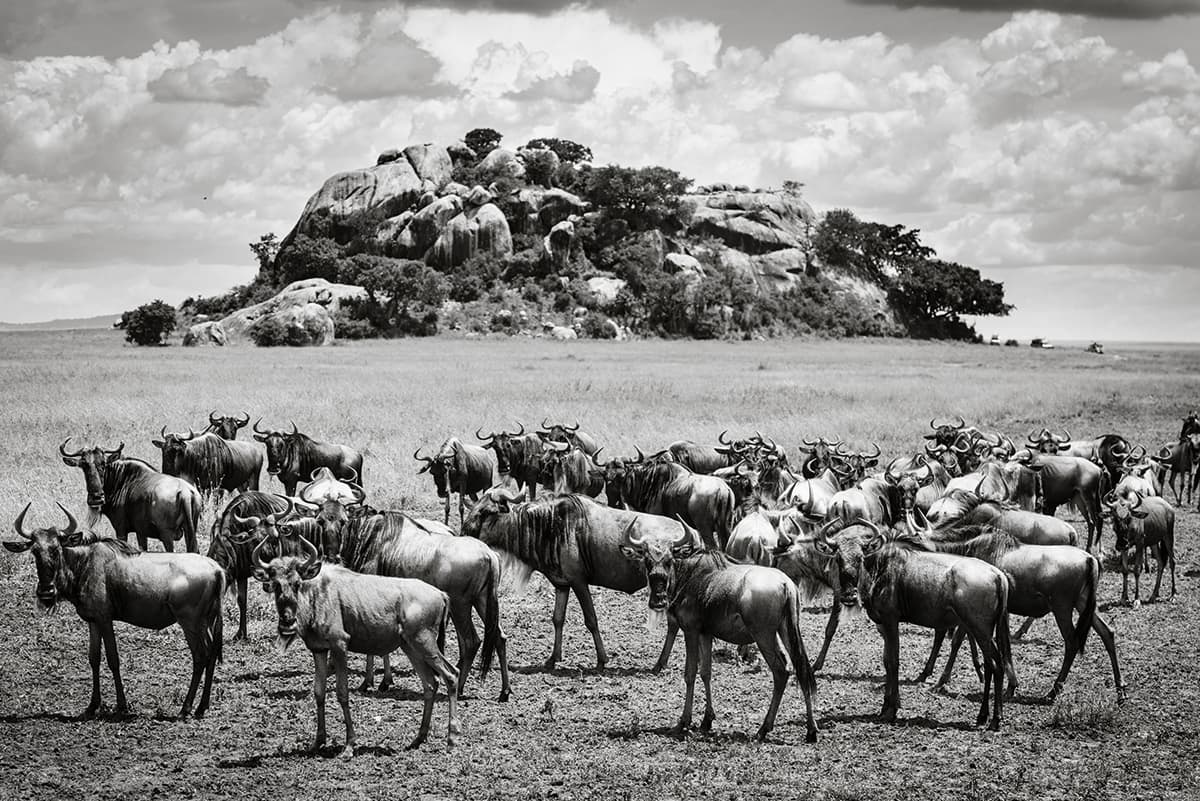
Wildebeest (Connochaetes taurinus) herd arriving at Simba Kopjes, Serengeti National Park, Tanzania
While this may be easy when taking photos close to home, it is decidedly more difficult abroad, but Elliott says the same principles apply – you still have to spend more time actually observing wildlife than taking photos of it.
Elliott is abroad a lot. He works as a guide for Oryx Photography (a wildlife photography tour operator in South Africa), and so has been fortunate enough to become familiar with locations such as Kenya’s Masai Mara, Tanzania’s Serengeti, Rwanda, the tiger reserves in central and northern India, and the high Arctic and Antarctica. Each tour generally only lasts 10-14 days, but he is never tempted to rapidly shoot everything he sees.
‘From my first-ever safari, where I shot more than 10,000 frames, I have now become extremely selective and cherry-pick encounters with the best light or action sequences,’ says Elliott. ‘Now I may shoot fewer than a thousand frames with three camera bodies. Occasionally, I will be single-minded and follow the same pride or cheetah, but I rarely do this when I am leading a group as most people are not prepared to wait around for hours, if not days, with the same animals.’
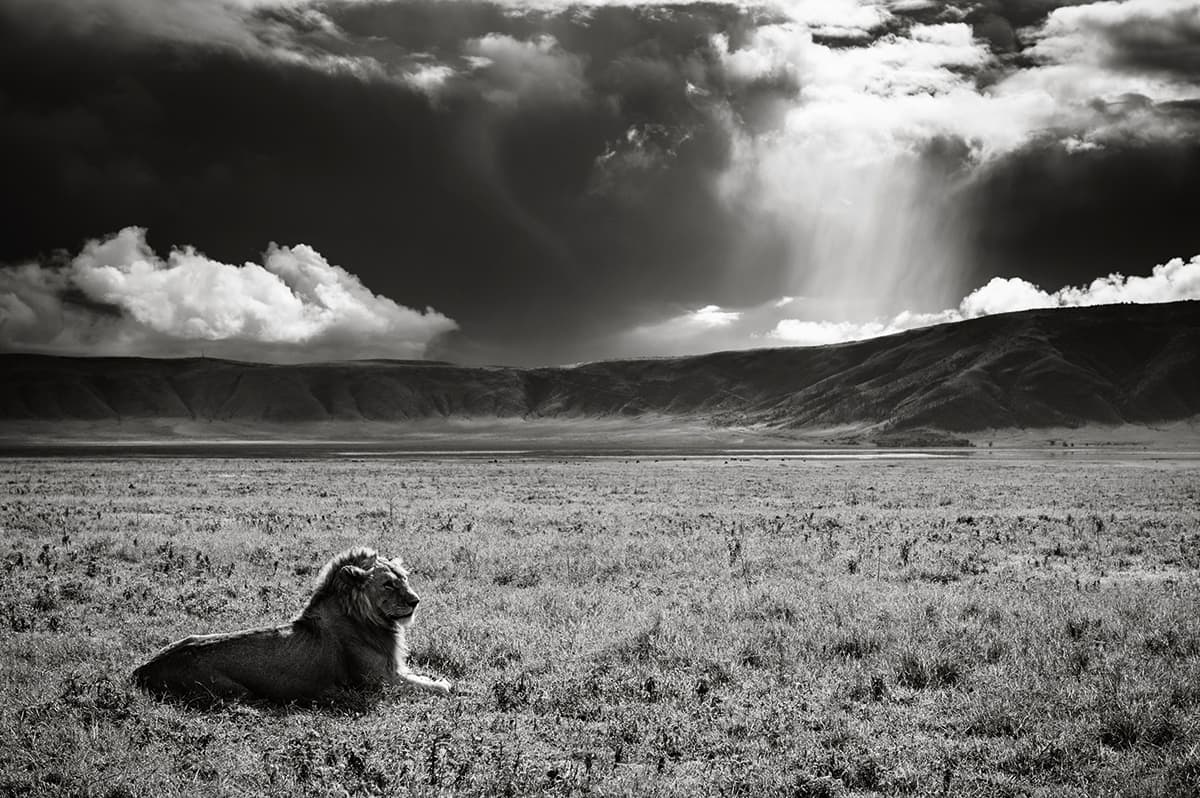
Photographing Wildlife – African lion (Panthera leo nubica) relaxing in the sunlight, underneath a stormy sky. Photographed in the Ngorongoro Crater, Tanzania
And yet if those touring photographers were willing to stick around, they would find that this slow approach is key to getting the right composition to bring their wildlife photos to life. At a basic level, Elliott’s composition technique is a standard approach honed during his years providing photographs for stock libraries.
He grew used to composing his images for copy space, with space above the head in vertical portraits and space on the side for the subject to look into. This style, based on the rule of thirds, is seen by many as somewhat boring, but Elliott says it is a useful foundation from which to be creative with how you shoot, so long as you have given yourself enough time to experiment.
‘I push the boundaries of the rule of thirds, with compositions such as a 90:10 split for landscapes and contextual images [animals in their environment]. These images consist of just a strip of land at the bottom and a big sky, or vice versa,’ he explains. ‘In contrast to this, when I’m sitting with a pride of lions or a herd of zebra, I look for tight compositions with my Nikkor 600mm f/4, picking out isolating abstractions or patterns and lines.’
Unsure of the best glass to buy for an upcoming safari trip or other wildlife expedition? Take a read of our Best lenses for wildlife photography in 2023 article for more.
Elliott often achieves the latter by filling the frame with motion, using slow shutter speeds on his Nikon D800 and D800E to blur the movement of running animals or flocks of birds. He also favours a panoramic crop at 2:1 or 3:1, with the huge 36.3MP file on the D800 giving him the image quality and size to crop to that letterbox style.
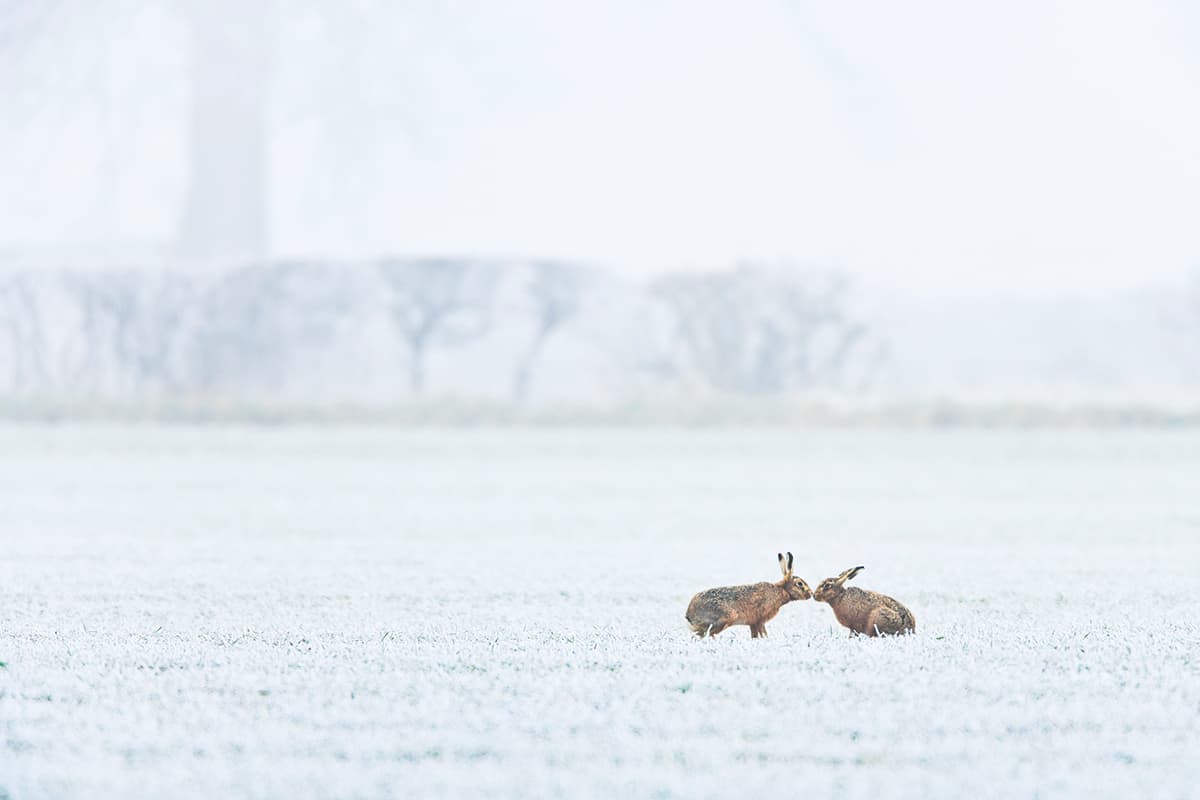
Two adult brown hares (Lepus europaeus), face to face in a frosty field, Rutland
Photographing Wildlife – Technique
Elliott is not one to try all these techniques in rapid succession. Rather, he is highly selective about when he releases the shutter. ‘I’m most definitely not a “machine-gunning” photographer who takes aim and hopes for the best,’ he reveals. ‘I am highly selective, picking moments that give me the body position I want: far front foot raised in stride to open the chest, eye contact (down the lens or another animal in frame), ears forward, and so on. I’ll also look for great light: warm, golden light at either end of the day, side-lighting or back-lighting my subject.’
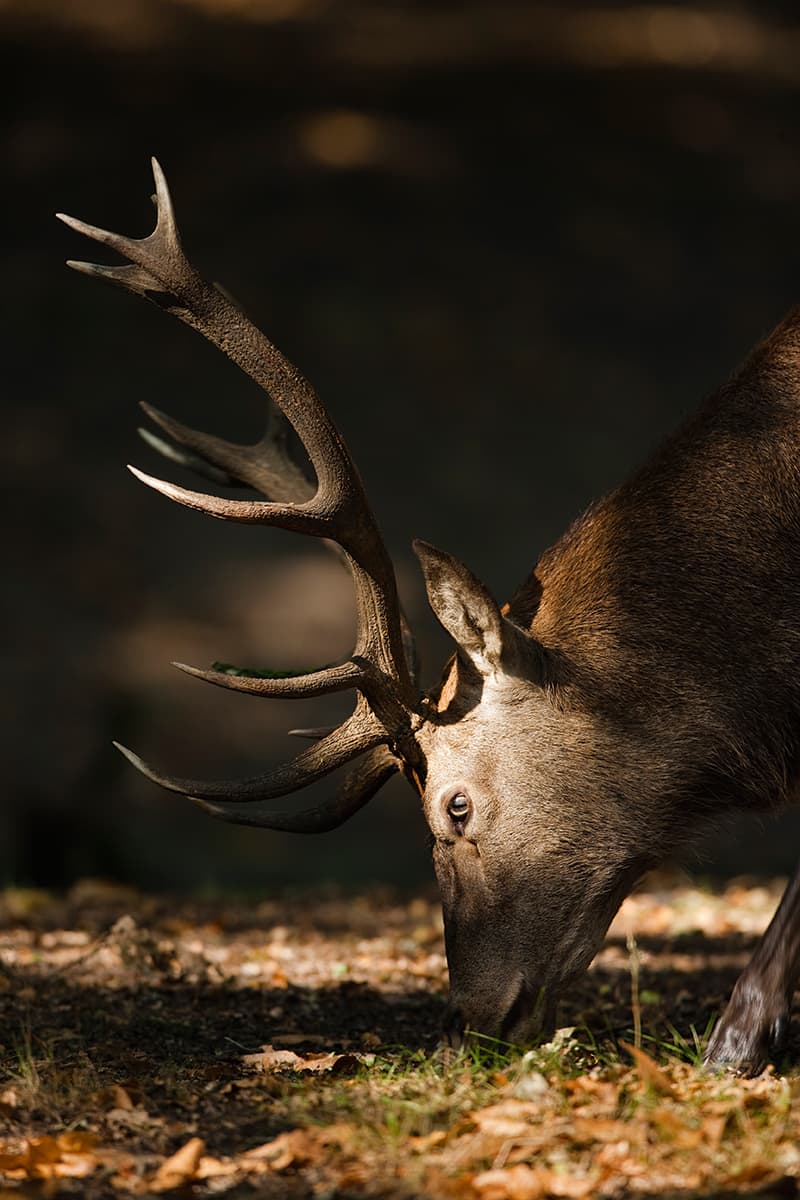
Red deer (Cervus elaphus) stag foraging for sweet chestnuts, England
However, if the atmospheric conditions don’t play ball, Elliott will make the most of his time in the field, such as using motion blurs when the light is low or poor.
‘I love the rain,’ reveals Elliott. ‘I will always continue photographing in the rain, just throwing a cover or a jacket over my lens. I’ll try to position the vehicle so I’m shooting into the light if possible, with a darker background so the raindrops stand out, and I use a slower shutter speed to blur the rain.’
Photographing Wildlife – Shoot responsibly
While Elliott is happy to make do with less-than-ideal conditions, he will never keep shooting if the animals are at risk, or if it means disturbing them unnecessarily.
‘Only recently, several newspapers documented Richmond Park as a prime example where armies of photographers were disturbing the rut with little or no thought for the animals,’ explains Elliott.
On safari, he is constantly assessing the scene and behaviour of the animals as they react to his presence. ‘Once, an elephant I was riding on to get photos disturbed a mother tigress. I have never forgotten the feeling of shame and have striven to avoid making the same mistake again,’ admits Elliott.
How do you photograph wildlife ethically?
Back in the UK, he uses field skills to stay undetected, such as shooting from hides and using camera traps, and he often uses food to attract wildlife.
‘I do use food to attract particular wildlife subjects into range of cameras, whether they’re remote or in my hand,’ explains Elliott. ‘I’ll usually attract birds with various foods, such as seeds, nuts, fruit and mealworms, and badgers with earthworms and honey. Sometimes I’ll try to use naturally occurring food, so this often means scraping roadkill off the road to attract foxes.’

Full-face close-up portrait of a dog red fox (Vulpes vulpes), England
Using food to attract wild animals is one that divides people. Elliott is keen to point out that he only uses this method with long-term projects with a long lead-in and lead-out, using enough food for the animals to be attracted to the vicinity, but not enough to create dependency.
For Elliott, that close interaction is as rewarding as seeing the final photographs. ‘It’s an absolute privilege to spend so much time in the company of these wild animals,’ he says. It is this attitude that ensures he captures not just the appearance of the animals he photographs, but their spirit too.
To find out more about responsible wildlife photography, check out these guidelines on how to be an ethical wildlife photographer.
Favourite locations in Britain and the UK
‘The Isle of Mull is just spectacular as a wild place: it is mountainous, with deep, cutting valleys and sea lochs,’ says Elliott. ‘It is home to the golden eagle, white-tailed sea eagle, red deer and otters – four species synonymous with the wild. It is my go-to location for otters and I’ve come to know the coastline extremely well, even advising other photographers where to go. I never go there to photograph eagles as they are still out of reach, even with a 600mm prime lens, but I love seeing them soaring above and gliding through the valleys.
If you’re just starting out in wildlife photography and fancy learning more, our Complete guide to wildlife photography will help you on your way – from research, the kit you need and how to setup your camera.
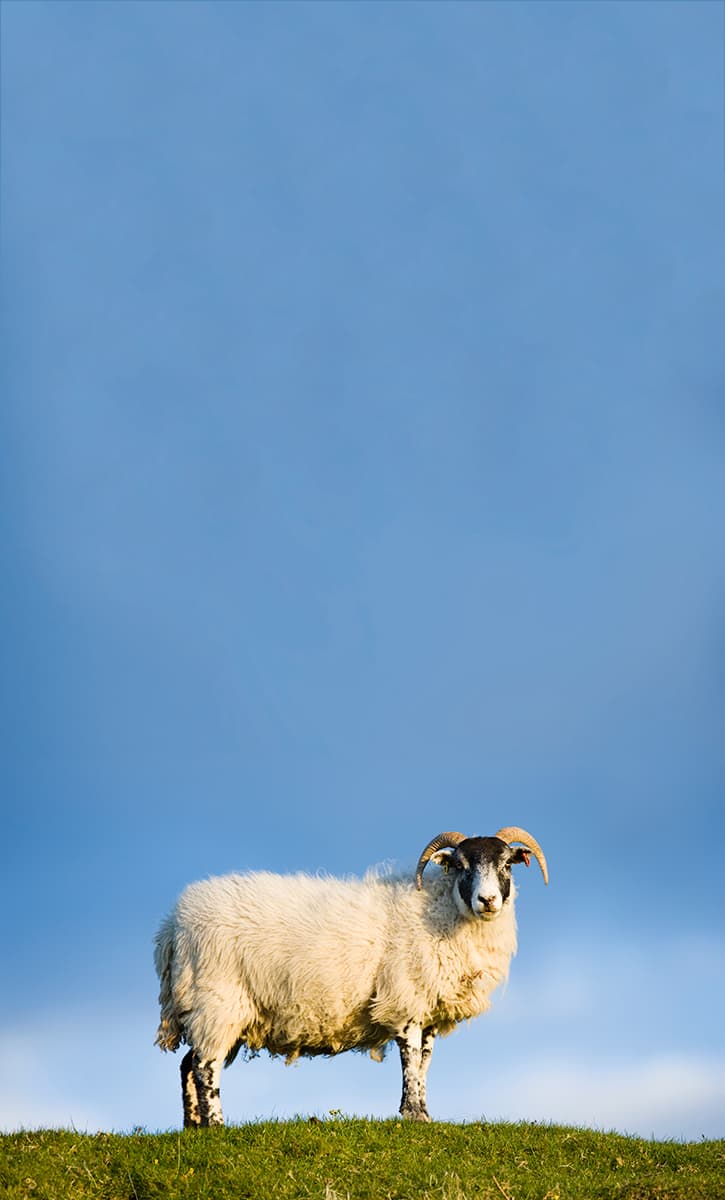
Scottish blackface sheep (Ovis aries). A ram standing against the blue sky, Isle of Mull, Argyll and Bute
‘Skomer Island is another gem in the UK’s wildlife crown. I prefer it to the Farne Islands for the Atlantic puffin as it is much larger and greener, with swathes of spring flowers, and the daily landings are more practical. You can also stay overnight to be there for sunrise and sunset, which is a stunning opportunity, and one I am looking forward to in June 2016.’
Photographing Wildlife – What camera gear do you need?
‘In my bag, I usually have a super-wide zoom, like a 16-35mm f/4 VR, mid-telephoto 70-200mm, 200-400mm and Nikkor 600mm f/4 VR II prime, plus an external flashgun or two,’ says Elliott. ‘I use a Gitzo 1325 Series 3 tripod, beanbags and an Eckla Eagle door support system.’
Recommended lenses for animal photography
- Wide-angle lens for landscapes with huge skies, and for those moments where the animals approach really close.
- Mid-range zoom (70-200mm or 75-300mm or equivalent) will give you the flexibility to photograph herds, packs and landscape details.
- Super-telephoto (400+mm or equivalent) to get you into the action, frame-fillers and birdlife. They also make great landscape lenses.
Often you will see features in the landscape that photograph well as isolated graphic images: good examples are the classic silhouette of an acacia with the orb of the sun. On safari, Elliott’s Nikkor 600mm f/4 VRII is permanently bolted to a camera body, as the image quality and ability to diffuse backgrounds make it an essential lens.
Elliott Neep is a photographer, guide and ardent conservationist. He has spent around 10 years studying the natural world, has been featured in several publications and has won a variety of awards for his work. To see more, visit Elliot’s website and Instagram.
Original article Jade Lord, with contributions from Michael Topham.
Related reading:
How to shoot wildlife photography – beginners guide
The best budget telephoto lenses for wildlife photography in 2023
How to capture fast-moving birds (and animals)
Marsel van Oosten – why you should photograph wildlife at low angles
Check out the top 15 best wildlife photos!

